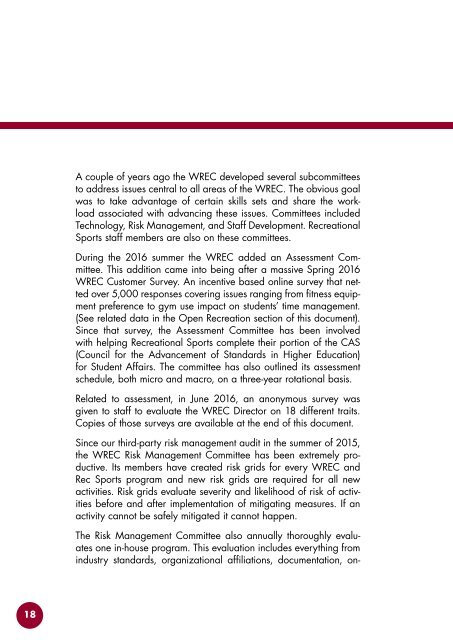WREC Year End Report
You also want an ePaper? Increase the reach of your titles
YUMPU automatically turns print PDFs into web optimized ePapers that Google loves.
COMMITTEES<br />
A couple of years ago the <strong>WREC</strong> developed several subcommittees<br />
to address issues central to all areas of the <strong>WREC</strong>. The obvious goal<br />
was to take advantage of certain skills sets and share the workload<br />
associated with advancing these issues. Committees included<br />
Technology, Risk Management, and Staff Development. Recreational<br />
Sports staff members are also on these committees.<br />
During the 2016 summer the <strong>WREC</strong> added an Assessment Committee.<br />
This addition came into being after a massive Spring 2016<br />
<strong>WREC</strong> Customer Survey. An incentive based online survey that netted<br />
over 5,000 responses covering issues ranging from fitness equipment<br />
preference to gym use impact on students’ time management.<br />
(See related data in the Open Recreation section of this document).<br />
Since that survey, the Assessment Committee has been involved<br />
with helping Recreational Sports complete their portion of the CAS<br />
(Council for the Advancement of Standards in Higher Education)<br />
for Student Affairs. The committee has also outlined its assessment<br />
schedule, both micro and macro, on a three-year rotational basis.<br />
Related to assessment, in June 2016, an anonymous survey was<br />
given to staff to evaluate the <strong>WREC</strong> Director on 18 different traits.<br />
Copies of those surveys are available at the end of this document.<br />
Since our third-party risk management audit in the summer of 2015,<br />
the <strong>WREC</strong> Risk Management Committee has been extremely productive.<br />
Its members have created risk grids for every <strong>WREC</strong> and<br />
Rec Sports program and new risk grids are required for all new<br />
activities. Risk grids evaluate severity and likelihood of risk of activities<br />
before and after implementation of mitigating measures. If an<br />
activity cannot be safely mitigated it cannot happen.<br />
The Risk Management Committee also annually thoroughly evaluates<br />
one in-house program. This evaluation includes everything from<br />
industry standards, organizational affiliations, documentation, onsite<br />
reviews, etc. Due to the ever-growing nature of Sport Clubs and<br />
increased requirement in the area of concussion protocol, game<br />
management and athletic training, this was the program that was<br />
reviewed in 2016-17.<br />
With the language around who is authorized to administer an Epipen<br />
injection so unclear, many Epipen certifications are no longer<br />
being recognized. Certainly, this topic is a major concern to AO,<br />
and even the <strong>WREC</strong> as a whole, so the Risk Management Committee<br />
tackled this issue this year. In short, the committee wrote its own<br />
course curriculum and had it certified by the California Emergency<br />
Medical Services Authority. The <strong>WREC</strong> is now one of only seven certified<br />
approved training programs in the state. The curriculum is now<br />
one of the classes available to students through the <strong>WREC</strong> safety<br />
class schedule and has already trained 30+ AO staff and Adventure<br />
Day Camp Counselors.<br />
The Risk Management Committee’s analysis of the <strong>WREC</strong> Incidents<br />
and Accidents for 2016/17 showed a significant increase this year<br />
in both categories. However, the types of injuries, the locations they<br />
occurred and time of day remained fairly constant. This suggests<br />
much of the increase is due to better and more consistent reporting<br />
as was a goal of the committee. 2016/17 data is much more in line<br />
with similar data from 2011 through spring 2015.<br />
The data shows that close to half of the injuries occur in Open Recreation<br />
and on the basketball courts. Obviously, the vast majority of<br />
these are ankle sprains. The next highest total for type and locations<br />
of injuries are lacerations and the MAC court. Elbows and heads<br />
often come together in both basketball and indoor soccer creating<br />
this data spike.<br />
A third of the incidents were medical in nature ranging from suicidal<br />
behavior to blood found (not reported) on the basketball court to<br />
18<br />
19



